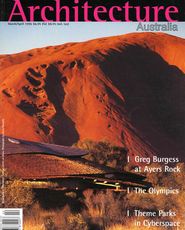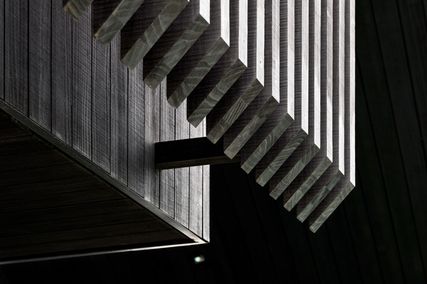Every second March, Adelaide becomes the centre of Australia’s high culture—and this year, for the first time, architecture is seriously part of the action. Melbourne theatre director Barrie Kosky has been driving the 1996 Adelaide Arts Festival towards cross-disciplinary collaborations including architects—and the Royal Australian Institute of Architects has picked up the baton to schedule a conference called Intersections, which explores the relationship of architecture and art. Next issue, Architecture Australia will report on the cross-currents debated by RAIA conference speakers and revealed in festival installations—but here is a guide to the principal highlights for architects. Although the festival runs from the end of February to March 17, this action all happens in the final week: March 11-17.
Intersection: The Meeting of Art and Architecture
This year’s RAIA international conference, March 13-15, explores a favourite theme of South Australian architecture; the collaboration of architects with artists and artisans. While international megastars are thin on the programme, the intellectual agenda is stimulating and the cast of Australian speakers is impressive and diverse.
 Peter Corrigan’s newspaper clipping of Francis Bacon.
Peter Corrigan’s newspaper clipping of Francis Bacon.
Highlights will be the opening address on March 14 by the Prime Minister (in post election mode), a debate “that architecture is a dying art” (let’s hope participants bring their wit), and seminars on architects’ visions, artists’ visions, the power of the idea, housing and art, the practice of collaboration and preservation of the meanings and differences of cultures.
Overseas guests include Deanna Petherbridge, Professor of Drawing at London’s Royal College of Art and a writer on the topic of art and spatial politics, and Francesco Mendini, brother and partner of Italian design guru Alessandro Mendini.
Australian speakers include architects Peter Corrigan, John Denton, Andrew Andersons and Alex Tzannes; artists Janet Laurence, Richard Goodwin, Richard Dunn and David O’Halloran; graphic designer Garry Emery and landscape architect Catherin Bull.
The conference is likely to generate a statement for submission to this year’s international conference on art and architecture in Denmark, at which a global charter on integrating art and architecture is to be drafted.
Adelaide Arts Festival
 Jeanne Sillett’s grid of crocuses. Image: Mark Van Den Enden
Jeanne Sillett’s grid of crocuses. Image: Mark Van Den Enden
Ruins of the Future
RMIT’s Dean of Environmental Design and Construction, Professor Leon van Schaik, has curated an exhibition of six outdoor installations by six international teams of artists and architects; to be inspected in Linear Park, along the southern banks of the Torrens River between the Adelaide Festival Centre and just beyond the Weir. These ‘ruins’ are promised to reveal “shards of our current conceptions of cities and the lives we lead in them”.
Three teams were invited to participate; the other three won a competition (attracting 80 entries) which was judged by Barrie Kosky, Ignazi de Sola Morales, Judith Brine and van Schaik. The proposals (subject to development) were:
Jeanne Sillett , London: Flowering crocuses precisely planted to correspond to Colonel Light’s original Adelaide grid; a thin blue line mown down after flowering, to emerge months later as an enigmatic blue haze. First prize in the competition.
Sand Helsel, Michael Leeton and Kate Pointon , Melbourne: A project called Atlas to guide visitors on a specific journey around Linear Park via a booklet, a set of postcards, samples from all six sites, an information kiosk and sixteen orange stakes. Second prize in the competition.
David Havercroft and Eleanor Suess , Perth: A theatre flat representing a house reminiscent of one in Peter Greenaway’s film The Draughtsman’s Contract . Window-shaped punctures frame views of the landscape, and the traditional style of the house is intended to hint at the European origins of our ways of seeing. Third prize.
 Image from a prototype document for Sand Helsel, Michael Leeton and Kate Pointon’s Atlas project. Image: Mark Van Den Enden
Image from a prototype document for Sand Helsel, Michael Leeton and Kate Pointon’s Atlas project. Image: Mark Van Den Enden
Mark Robbins , Ohio: A composition of traces—towel racks, insect traps, fishing nets, a shadow theatre—of hopes, desires and ephemeral lives; an exploration of this artist’s preoccupation with days and nights at the Weir. Invited participant.
Rodney Place with Warrick Swinney , Philadelphia: The Lost World of the Pacific—a water structure, including sound, inspired by the post-war migrant ships that came to Australia, and accessible by the small paddle boats which can be hired on the Torrens. Invited.
Kathryn Findlay and Eisaku Ushida , Tokyo: A sweeping canopy made of brush as used for many suburban fences in Adelaide; a structure linking ideas of the bush, suburbia, shelter and homelessness. Invited.
Observers of these installations have a variety of philosophical issues to consider; not least the merit of the exhibition concept. The project has attracted criticism from both conservative local quarters (custodians have cried: “don’t ‘ruin’ our park!”) and from artists concerned about ‘object fetishism’. Curator van Schaik answers that “I believe our installations are far more serious than this … these follies are engines that should stop us in our tracks and make us consider consciously the future we are thoughtlessly choosing day in, day out”.
A Bow of Burning Gold: Some Arrows of Desire
Melbourne architect Peter Corrigan, who often designs sets for Barrie Kosky’s productions, is exhibiting at Artspace in the Festival Centre a room dressed with memorabilia he has collected throughout his career; this will map influences on his architecture. “It’ll be a tight 19th century hang: you know, at least three rows,” says Corrigan. Look for Japanese prints, a button from Paris’ Crazy Horse saloon, illustrations by Brian Burr and other friends, and “a bit of smutty stuff and bits and pieces I’ve torn out of newspapers”. Note that we show a clipping; he deemed his smut unsuitable for our tender readers.
Harry Seidler
In the foyer of the Festival Centre, Harry Seidler presents a distillation of the exhibition of his work which has been touring Europe: the projects of current note are his Vienna housing development and the gold version of the two Grollo tower proposals for Melbourne.
Alvar Aalto: Points of Contact
Already seen in several cities but certainly worth repeat visits is this exhibition of Aalto furniture, drawings, photographs and models; compiled by the Alvar Aalto Museum in Finland. Two projects are represented in depth: the Paimio Sanatorium and the Villa Mairea.
Art Across the Oceans: 96 Containers
The South Australian Maritime Museum at Port Adelaide is displaying seven shipping containers incorporating installations by four Australian and three New Zealand artists. These will be shipped to Copenhagen for waterfront display with another 89 containers converted by artists around the world.
Off the Rails
Sydney artist Anne Graham has prepared an installation within the Concourse of the Adelaide Railway Station: breaking up the space to revise the passages and experiences of people walking through. Her themes: travel, escapism, displacement and desire.
Light
Writer Paul Carter and artist Hossein Valamanesh have prepared a sound and light sculpture—a “multilingual voice collage”—exploring the last months and inner life (as revealed in diary entries) of Adelaide’s founder, Colonel William Light. Their installation is distributed along Pinky Flat on the north bank of the Torrens.
 Rodney Place and Warwick Swinney’s The Lost World of the Pacific. Image: Cascadilla.
Rodney Place and Warwick Swinney’s The Lost World of the Pacific. Image: Cascadilla.
Compost
Fifteen artists exhibit installations in private homes in suburban Norwood, March 7-15. See work by Maria Kozic, Hany Armanious, Stephen Bram, Howard Arkley, Christopher Snee and others.
Catalyst
Young Adelaide designers exhibit “cutting edge” yet “production-ready” furniture at the Art Images Gallery, Norwood; these 15-20 pieces are intended to be sold nationally on a commercial basis. The designers are Studio ARKeTYPE, designPOD, Malcolm Pedlar, Colin Burgin, Ian Rooney and Ian McKenzie.















